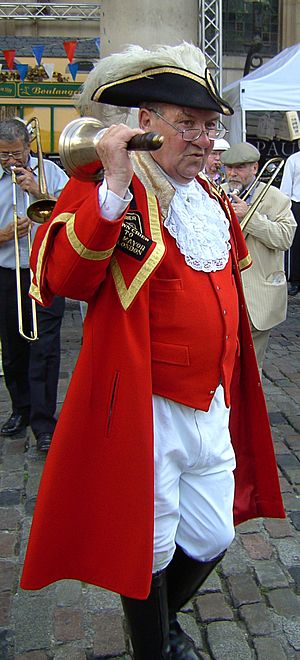Town crier facts for kids
A town crier is a special person who works for a town council. Their job is to make important announcements to everyone in the streets. They might also share news in court or for official events. Town criers often wear fancy clothes, a tradition that started a long time ago in the 1700s. They usually wear a red and gold robe, white breeches (which are like short trousers), black boots, and a tricorne hat (a hat with three corners).
They carry a handbell to make a loud noise and get people's attention. Before they speak, they shout the words "Oyez, Oyez, Oyez!" The word "Oyez" means "hear ye," which is a way of saying "listen up!" or "pay attention!" It comes from an old Anglo-Norman word for "listen." Sometimes, what town criers announce is written down in special books called Proclamation Books. For example, a book from Chester in the early 1800s shows that the town crier would shout "O Yes, O Yes!"
Contents
History of Town Criers
Spreading News in England

In Medieval England, town criers were super important for sharing news with people. This was because many people couldn't read newspapers back then. For hundreds of years, a bellman or town crier would announce royal proclamations (official messages from the king or queen), local bylaws (town rules), market days, and even advertisements. They even announced when things like loaves of sugar were for sale! For example, in 1798, the Chester Canal Company used the town crier to advertise sugar that got wet and damaged on their packet boat.
The first "belman" in Chester was recorded in 1540. He was paid a small amount of money (one old penny) to look for lost things. He also got four old pennies to lead funeral processions. In 1681, a new fire safety rule said that all houses should have tiled roofs instead of thatched ones. This rule was announced "throughout the city by the day bellman." In 1553, the crier was paid 13 old pennies to "ridunge the banes" (read the announcements or adverts) for the famous Chester Mystery Plays. In 1598, a bellman named Richard Woodcock had a special wooden stick decorated with silver.
In 1620, there was a fight between butchers and bakers at the crossroads. The "Cryer brake his Mace in peeces Amonge them," meaning he broke his silver stick trying to stop the fight! In 1607, George Tunnall, the bellman, read a public notice saying it was against the law to throw rubbish in the river. In 1656, a church record in Gloucester shows that marriage announcements were "published by the Bellman."
In 1715, a local person wrote that the "Belman at the Cross" would "Reads publicly a proclamation in the Mayor's name." This message told everyone in the city to behave peacefully and not to walk around the streets late at night. In 1743, John Posnitt became both the "Day and Night Bellman." By 1835, Chester seemed to have only one town crier. It wasn't until 1998 that Chester had both a crier and a bellman again.
Town criers were very important and were even protected by royalty. This was because they sometimes had to deliver bad news, like tax increases. Even today, any town crier in the British Commonwealth is protected by old English law. This law says they "are not to be hindered or heckled while performing their duties." This means no one can stop them or make fun of them while they are doing their job. If someone hurt a town crier, it was seen as an act of treason against the ruling monarchy (the king or queen). The phrase "Posting A Notice" comes from the town crier's tradition. After reading a message to the townspeople, they would attach it to the door post of the local inn.
Town Criers Across Europe
Just like in England, town criers were the main way to deliver news to people in other parts of Europe. Many people couldn't read or write, so they relied on the criers. Important announcements, local rules, market days, and advertisements were all shouted out by a bellman or crier.
Not all town criers were men; many women also held this important job. And bells weren't the only way to make noise! In Holland, a gong was often used. In France, a drum or a hunting horn was sometimes used to get people's attention.
Modern Town Criers
Today, we don't need town criers to spread news because we have newspapers, TV, and the internet. So, town criers have become part of local folklore and tradition. But they still exist! There are even European and World Championship competitions for modern town criers.
At the World Championships in 2008, Peter and Maureen Taunton from Stafford, UK, were named the best dressed town crier and escort. They also won the title of best dressed town crier in Britain in 2008 and at the National Town Crier Competition in Hastings in 2007.
Peter Moore has been The London Town Crier for over 30 years. He is the official Town Crier for The Mayor of London, The City of Westminster, and many London Boroughs. He is also a Freeman and Liveryman of The City of London.
Alan Myatt holds a world record for being the loudest town crier. He reached an amazing 112.8 decibels with his voice!
Images for kids
-
Town crier of Provincetown, Massachusetts, in 1909
-
A town criers competition in Thetford in 2015
See also
 In Spanish: Pregonero para niños
In Spanish: Pregonero para niños






